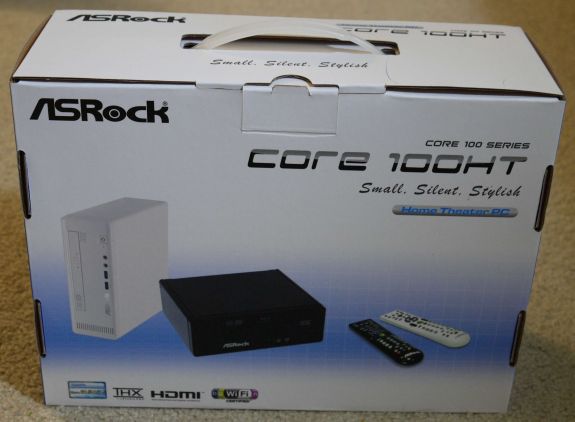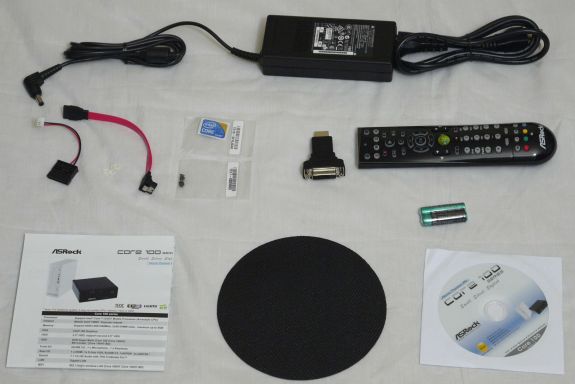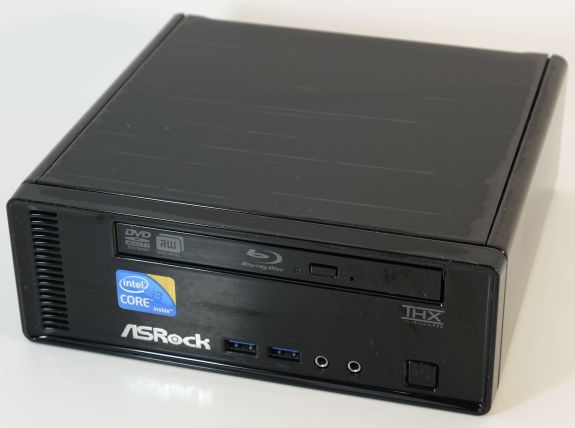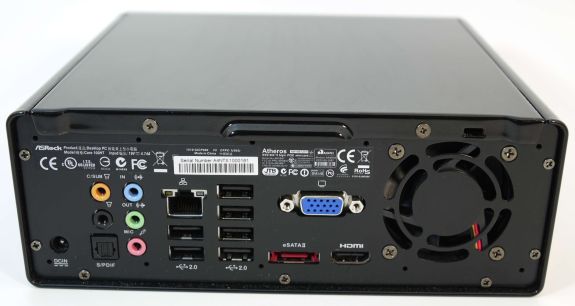ASRock Core 100HT-BD : Bringing HTPCs to the Mainstream Market [UPDATED : Noise Issue]
by Ganesh T S on July 19, 2010 9:34 PM EST- Posted in
- Home Theater
- Arrandale
- ASRock
- Media Streamer
- Core i3
- HTPC
The Core 100 HT-BD comes in a small package, and at first you wonder how such a powerful unit could come in such a small size.
Apart from the main unit, the package also bundles the following:
1. 90W AC / DC Adapter
2. SATA and power cables, as well as mounting screws for an optional second 2.5" hard disk
3. HDMI to DVI adapter
4. MCE remote and batteries.
5. Manual with instructions for disassembling and mounting the optional disk drive
6. Anti-slip pad for the base of the unit
7. CD with drivers and ASRock utilities
The appearance and dimensions of the unit are very similar to that of the ION 330-HT that was reviewed last August. The build quality of the chassis is top notch, and the unit will have no problem in blending with the A/V equipment of most consumers. However, the abrupt edges of the unit will not sit well with those interested more in the aesthetics and appearance rather than the internal capabilities of the unit. In the next iteration of the product, ASRock will probably work on the industrial design a bit more. Replacing the slimline Blu-Ray drive with a slot-loading type drive would also improve the appearance. These types of changes would enable them to cater to the segment of consumers who go more by the looks also.
We had mentioned in the ION 330 review about the absence of ports on the front panel being a bit strange, and ASRock has duly taken note, putting two USB 3.0 ports on the front panel. In addition, we also have headphone and microphone jacks in front. A set of vents on the left of the front panel helps in cooling the unit by maintaining air circulation. The slimline Blu-Ray drive is the same as those which make an appearance in various notebooks. The cost of such drives has come down drastically in the last 1 year, and we don't expect this component to add on too much cost over the DVD drive only version. Notably absent in the ION 330, but making an appearance in this unit is the THX logo above the power button to the right of the front panel.
ASRock uses the two sides of the unit as antennae for the Atheros WiFi module. Moving on to the rear of the unit, we find the adapter power input, followed by the audio ports. Analog audio output can be connected directly to the speakers, or the optical SPDIF output can be used to connect to older A/V receivers. Following this is the Gigabit Ethernet port, and 6 USB 2.0 slots. Further to the right, we have the VGA output (we really needed a DVI here), beneath which one gets the eSATA slot and HDMI output port. Wrapping up this panel is the ventilation fan. Our only gripe with the back panel is the placement of the eSATA port, which makes it difficult to connect external hard disks, particularly when the VGA port is being used.
Just like a notebook, this unit also supports simultaneous display on two monitors. Testing was done mostly with the HDMI output connected to a Toshiba REGZA 37" 1080p TV through an Onkyo TX-SR 606, and the VGA port connected to a old Dell monitor running at 1280x1024. It must be noted that the HDMI port on the unit is only 1.3a. This makes it impossible for the unit to drive monitors with resolutions higher than 1920x1080. Even extremely affordable 2048x1152 monitors such as this one from Dell are left unsupported at their maximum resolutions. However, we expect that this will not be a concern to buyers, since the unit will probably end up getting connected to a 1080p TV in most scenarios.
The Core 100 HT-BD ships with no OS installed. For the purpose of this review, we loaded up a copy of Windows 7 Ultimate x64. It is also possible to install Ubuntu or any other Linux distribution and still be able to take advantage of most of the HTPC functions of the system. Our analysis in the rest of the article, however, is completely from the Windows 7 standpoint.
Starting with this piece, all our media streamer and HTPC reviews will carry a table summarizing the data and A/V connectivity options for the unit from a home theater perspective. We will conclude this section with the same.
| Option | Status |
|---|---|
| HDMI | Yes [v1.3a] |
| Component | No |
| Composite | No |
| VGA | Yes |
| SPDIF | Yes [Optical] |
| Stereo | Yes |
| Option | Status |
|---|---|
| Optical Disk Drive | Yes [Blu-Ray] |
| USB | Yes [6 x v2.0, 2 x v3.0] |
| eSATA | Yes |
| LAN | Yes [ 1000 Mbps GbE ] |
| Internal HDD | Yes [ 500 GB ] |
| WiFi | Yes [ 300 Mbps 802.11n ] |
| Card Reader | No |














107 Comments
View All Comments
spddemon - Tuesday, July 20, 2010 - link
This system is capable of dobly truHD and DTS HD. A ION system is not capable of decoding of those sounds format...So this system will appeal heavily to someone that wants a small nettop type system with a BD and good encoding performance. With any nettop you are going to have to use NAS storage anyways, but this system will allow more internal expansion than most others.. But if you wanted to, you could pair it with an external drive cage.. I wouldn't want that in my living room / theater room though.
biggest problem with this system is price.. You can build a great system for a couple hundred less if you are willing to take hours of researching the components and integration. A successful HTPC build will take considerable more time in planning/research than a typical PC/Gaming PC Build....
If you are wanting a powerful, small, efficient, prebuilt nettop, this is the best out there right now!
That is really the only thing i wish Ganesh would of pointed out a little more clearly. The capabilities of the "iGPU" vs an ION.. with the growth of this field, I would love to see a followup review that would pit a custom built (but comparable build) HTPC.. like a Core i3 530 (or maybe an e7200) / H55 with and without an ATI/NVIDIA (non ION) card. This would really give some people something to look at as far as capabilities..
and really, who cares what the remote looks like.. get a Logitech harmony or some other home automation remote... most people will only care about if the IR or RF functionality is already there...
ganeshts - Tuesday, July 20, 2010 - link
spddemon,Stay tuned for more HTPC reviews in this space. Their performance will be pitted against this solution.
However, ION is passe right now. We will be testing with the ATI 5xxx series and upcoming Nvidia cards.
Furuno - Wednesday, July 21, 2010 - link
Upcoming nVidia cards...Hmm I wonder what it is... A low-cost version of fermi or another rebranding of GT2XX cards?
ganeshts - Wednesday, July 21, 2010 - link
We already published reviews of the GTX460 from the gaming perspective.The card is good from a gaming HTPC perspective because it also supports HD audio bitstreaming.
There are some rumours that Nvidia has lower priced cards coming out in the next 2 months, so we will cover them when they get released :) At the least, we will cover the GTX460.
spddemon - Wednesday, July 21, 2010 - link
Thanks for the updates Ganeshts!It looks like your time frame will be perfect for my new HTPC project.
I really hope Nvidia can get some low powered cards out to offer a true HTPC card that covers all the current HD formats/codecs.
mindbomb - Wednesday, July 21, 2010 - link
Ion can only bitstream LPCM, but I assume the atom cpu is powerful enough to decode truehd in libavcodec.So that only leaves DTS-HD MA as a problem.
ganeshts - Tuesday, July 20, 2010 - link
Goty,The user can always opt for a USB TV tuner.
If we had an expansion slot for a TV tuner inside this box, the unit wouldn't be based off the HM55 chipset, and wouldn't fit in the sub-50 W power envelop which is a coveted mark in this space.
Further, including a TV tuner in the box would drive up the cost of the system in some areas, as it would be taxed as an entertainment device, rather than a computer.
bearxor - Tuesday, July 20, 2010 - link
No one that is serious about using this as a HTPC is going to string USB TV tuners off this thing. You want 2 USB tuners hanging off the back of the machine? How about 4?My HTPC has 7 tuners total. 2xHauppage 2250's, 2xCats Eye 150's and a ATi DCT. Tell me exactly where I'm going to be able to put those on a machine like this.
There needs to be some kind of market differentiation between a HTPC and a Living Room PC. One is for serious use as a DVR and the other is to hook up to the TV and watch some videos/play games/surf the web/Facebook/chat, etc. They are two different markets.
ganeshts - Tuesday, July 20, 2010 - link
bearxor,You have got an impressive set up.
However, I believe your type of setup is more the exception rather than the norm. The sort of arrangement which will remain a niche for a long time to come. With the advent of IP streaming and availability of TV shows and live sports broadcasts online, I am not even sure people will require so many tuners.
I also think that your sort of setup isn't amenable to the silent, power efficient HTPC that people want (particularly from the viewpoint of media streamers and boxes such as the upcoming Google TV). The latter 'living room PC' that you mention has more potential to explode as a market for manufacturers to exploit, rather than the DVR-centric PC that you envisage.
hughlle - Tuesday, July 20, 2010 - link
Exactly, 7 tuners is hardly the norm. I make do without a single one on my HTPC, i have the likes of iplayer if i really feel inclined to drop into the fantastic realm that is daytime television :S